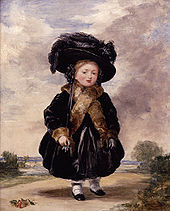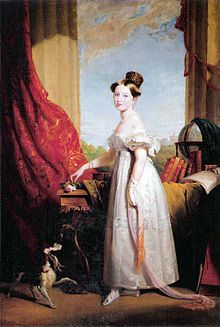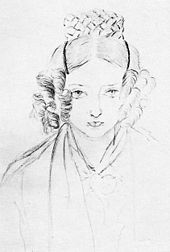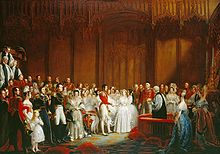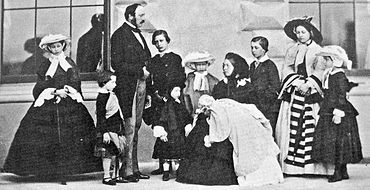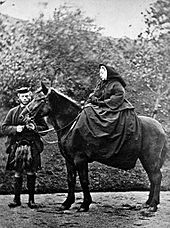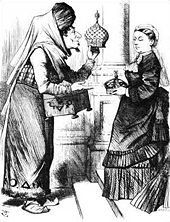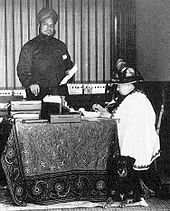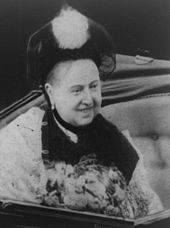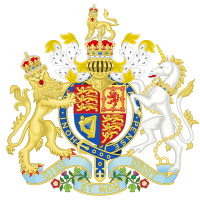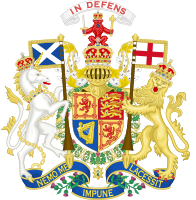- Queen Victoria
-
For other uses, see Queen Victoria (disambiguation).
Victoria 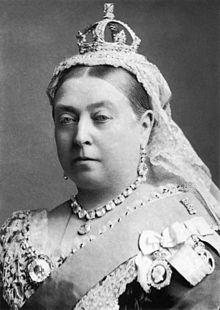
Victoria wearing her small diamond crown
Photograph by Alexander Bassano, 1882Queen of the United Kingdom Reign 20 June 1837 – 22 January 1901 Coronation 28 June 1838 Predecessor William IV Successor Edward VII Prime Ministers See list Empress of India Reign 1 May 1876 – 22 January 1901 Imperial Durbar 1 January 1877 Predecessor Title created Successor Edward VII Viceroys See list Consort Prince Albert of Saxe-Coburg and Gotha Issue Full name Alexandrina Victoria House House of Hanover Father Prince Edward, Duke of Kent and Strathearn Mother Princess Victoria of Saxe-Coburg-Saalfeld Born 24 May 1819
Kensington Palace, LondonDied 22 January 1901 (aged 81)
Osborne House, Isle of WightBurial 4 February 1901
Frogmore, WindsorSignature 
Victoria (Alexandrina Victoria; 24 May 1819 – 22 January 1901) was the monarch of the United Kingdom of Great Britain and Ireland from 20 June 1837 until her death. From 1 May 1876, she used the additional title of Empress of India.
Victoria was the daughter of Prince Edward, Duke of Kent and Strathearn, the fourth son of King George III. Both the Duke of Kent and the King died in 1820, and Victoria was raised under close supervision by her German-born mother Princess Victoria of Saxe-Coburg-Saalfeld. She inherited the throne at the age of 18 after her father's three elder brothers died without surviving legitimate issue. The United Kingdom was already an established constitutional monarchy, in which the Sovereign held relatively few direct political powers. Privately, she attempted to influence government policy and ministerial appointments. Publicly, she became a national icon, and was identified with strict standards of personal morality.
She married her first cousin, Prince Albert of Saxe-Coburg and Gotha, in 1840. Their 9 children and 26 of their 34 grandchildren who survived childhood married into royal and noble families across the continent, tying them together and earning her the nickname "the grandmother of Europe". After Albert's death in 1861, Victoria plunged into deep mourning and avoided public appearances. As a result of her seclusion, republicanism temporarily gained strength, but in the latter half of her reign, her popularity recovered. Her Golden and Diamond Jubilees were times of public celebration.
Her reign of 63 years and 7 months, which is longer than that of any other British monarch and the longest of any female monarch in history, is known as the Victorian era. It was a period of industrial, cultural, political, scientific, and military change within the United Kingdom, and was marked by a great expansion of the British Empire. She was the last British monarch of the House of Hanover; her son and successor King Edward VII belonged to the House of Saxe-Coburg and Gotha.
Contents
Birth and family
Victoria's father was Prince Edward, Duke of Kent and Strathearn, the fourth son of the reigning King of the United Kingdom, George III. The Duchess of Kent, Princess Victoria of Saxe-Coburg-Saalfeld, was a German princess whose brother Leopold was the widower of Princess Charlotte of Wales. Until 1819 Charlotte was the only legitimate grandchild of George III. Her death in 1817 precipitated a succession crisis in the United Kingdom that brought pressure on the Duke of Kent to marry and have children. He married the Duchess in 1818, and their only child Victoria was born at 4.15 am on 24 May 1819 at Kensington Palace in London.[1]
She was christened privately by the Archbishop of Canterbury, Charles Manners-Sutton, on 24 June 1819 in the Cupola Room at Kensington Palace.[2] Her parents proposed to call her Victoire Georgina Alexandrina Charlotte Augusta, but on the instructions of the Duke's elder brother, the Prince Regent (later George IV), three of the names were dropped. She was baptised Alexandrina, after one of her godparents, Emperor Alexander I of Russia, and Victoria after her mother.[3]
At birth, Victoria was fifth in the line of succession after her father and his three older brothers: the Prince Regent, the Duke of York, and the Duke of Clarence (later William IV).[4] The Prince Regent was estranged from his wife and the Duchess of York was 52 years old, so the two eldest brothers were unlikely to have any further children. The Dukes of Kent and Clarence married on the same day 12 months before Victoria's birth, but both of Clarence's daughters (born in 1819 and 1820 respectively) died as infants. Victoria's grandfather and father died in 1820, within a week of each other, and the Duke of York died in 1827. On the death of her uncle George IV in 1830, she became heiress presumptive to her next surviving uncle, William IV. The Regency Act 1830 made special provision for the Duchess of Kent to act as regent in case William died while Victoria was still a minor.[5] King William distrusted the Duchess's capacity to be regent, and in 1836 declared in her presence that he wanted to live until Victoria's 18th birthday, so that a regency could be avoided.[6]
Heiress to the throne
Victoria later described her childhood as "rather melancholy".[7] Her mother was extremely protective, and Victoria was raised largely isolated from other children under the so called "Kensington System", an elaborate set of rules and protocols devised by the Duchess and her ambitious and domineering comptroller, Sir John Conroy, who was rumoured to be the Duchess's lover.[8] The system prevented the princess from meeting people whom her mother and Conroy deemed undesirable (including most of her father's family), and was designed to render her weak and dependent upon them.[9] The Duchess avoided the court because she was scandalised by the presence of the King's bastard children,[10] and perhaps prompted the emergence of Victorian morality by insisting that her daughter avoid any appearance of sexual impropriety.[11] Victoria shared a bedroom with her mother every night, studied with private tutors to a regular timetable, and spent her play hours with her dolls and her King Charles spaniel, Dash.[12] Her lessons included French, German, Italian, and Latin,[13] but she spoke only English at home.[14]
In 1830, the Duchess of Kent and Conroy took Victoria across the centre of England to visit the Malvern Hills, stopping at towns and great country houses along the way.[15] Similar journeys to other parts of England and Wales were taken in 1832, 1833, 1834 and 1835. To King William's annoyance, Victoria was enthusiastically welcomed in each of the stops.[16] William compared the journeys to royal progresses and was concerned that they portrayed Victoria as his rival rather than his heiress presumptive.[17] Victoria disliked the trips; the constant round of public appearances made her tired and ill, and there was little time for her to rest.[18] She objected on the grounds of the King's disapproval, but her mother dismissed his complaints as motivated by jealousy, and forced Victoria to continue the tours.[19] At Ramsgate in October 1835, Victoria contracted a severe fever, which Conroy initially dismissed as a childish pretence.[20] While Victoria was ill, Conroy and the Duchess unsuccessfully badgered her to make Conroy her private secretary.[21] As a teenager, Victoria resisted persistent attempts by her mother and Conroy to appoint him to her staff.[22] Once Queen, she banned him from her presence, but he remained in her mother's household.[23]
By 1836, the Duchess's brother, Leopold, who had been King of the Belgians since 1831, hoped to marry his niece to his nephew, Prince Albert of Saxe-Coburg and Gotha.[24] Leopold, Victoria's mother, and Albert's father (Ernest I, Duke of Saxe-Coburg and Gotha) were siblings. Leopold arranged for Victoria's mother to invite her Coburg relatives to visit her in May 1836, with the purpose of introducing Victoria to Albert.[25] William IV, however, disapproved of any match with the Coburgs, and instead favoured the suit of Prince Alexander of the Netherlands, second son of the Prince of Orange.[26] Victoria was aware of the various matrimonial plans and critically appraised a parade of eligible princes.[27] According to her diary, she enjoyed Albert's company from the beginning. After the visit she wrote, "[Albert] is extremely handsome; his hair is about the same colour as mine; his eyes are large and blue, and he has a beautiful nose and a very sweet mouth with fine teeth; but the charm of his countenance is his expression, which is most delightful."[28] Alexander, on the other hand, was "very plain".[29]
Victoria wrote to her uncle Leopold, whom Victoria considered her "best and kindest adviser",[30] to thank him "for the prospect of great happiness you have contributed to give me, in the person of dear Albert ... He possesses every quality that could be desired to render me perfectly happy. He is so sensible, so kind, and so good, and so amiable too. He has besides the most pleasing and delightful exterior and appearance you can possibly see."[31] However at 17, Victoria, though interested in Albert, was not yet ready to marry. The parties did not undertake a formal engagement, but assumed that the match would take place in due time.[32]
Early reign
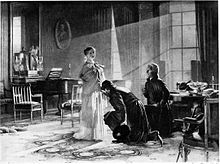 Victoria receives the news of her accession from Lord Conyngham (left) and the Archbishop of Canterbury.
Victoria receives the news of her accession from Lord Conyngham (left) and the Archbishop of Canterbury.
Victoria turned 18 on 24 May 1837, and a regency was avoided. On 20 June 1837, William IV died at the age of 71, and Victoria became Queen of the United Kingdom. In her diary she wrote, "I was awoke at 6 o'clock by Mamma, who told me the Archbishop of Canterbury and Lord Conyngham were here and wished to see me. I got out of bed and went into my sitting-room (only in my dressing gown) and alone, and saw them. Lord Conyngham then acquainted me that my poor Uncle, the King, was no more, and had expired at 12 minutes past 2 this morning, and consequently that I am Queen."[33] Official documents prepared on the first day of her reign described her as Alexandrina Victoria, but the first name was withdrawn at her own wish and not used again.[34]
Since 1714, Britain had shared a monarch with Hanover in Germany, but under Salic law women were excluded from the Hanoverian succession. While Victoria inherited all the British dominions, Hanover passed instead to her father's younger brother, her unpopular uncle the Duke of Cumberland and Teviotdale, who became King Ernest Augustus I of Hanover. He was her heir presumptive until she married and had a child.[35]
 Coronation Portrait of Queen Victoria by George Hayter
Coronation Portrait of Queen Victoria by George Hayter
At the time of her accession, the government was led by the Whig prime minister Lord Melbourne, who at once became a powerful influence on the politically inexperienced Queen, who relied on him for advice.[36] Charles Greville supposed that the widowed and childless Melbourne was "passionately fond of her as he might be of his daughter if he had one", and Victoria probably saw him as a father figure.[37] Her coronation took place on 28 June 1838, and she became the first sovereign to take up residence at Buckingham Palace.[38] She inherited the revenues of the duchies of Lancaster and Cornwall, and was granted a civil list of £385,000 per year. Financially prudent, she paid off her father's debts.[39]
At the start of her reign Victoria was popular,[40] but her reputation suffered in an 1839 court intrigue when one of her mother's ladies-in-waiting, Lady Flora Hastings, developed an abdominal growth that was widely rumoured to be an out-of-wedlock pregnancy by Sir John Conroy.[41] Victoria believed the rumours.[42] She hated Conroy, and despised "that odious Lady Flora",[43] because she had conspired with Conroy and the Duchess of Kent in the Kensington System.[44] At first, Lady Flora refused to submit to a naked medical examination, until in mid-February she eventually agreed, and was found to be a virgin.[45] Conroy, the Hastings family and the opposition Tories organised a press campaign implicating the Queen in the spreading of false rumours about Lady Flora.[46] When Lady Flora died in July, the post-mortem revealed a large tumour on her liver that had distended her abdomen.[47] At public appearances, Victoria was hissed and jeered as "Mrs. Melbourne".[48]
In 1839, Melbourne resigned after Radicals and Tories (both of whom Victoria detested) voted against a Bill to suspend the constitution of Jamaica. The Bill removed political power from plantation owners who were resisting measures associated with the abolition of slavery.[49] The Queen commissioned a Tory, Sir Robert Peel, to form a new ministry. At the time, it was customary for the prime minister to appoint members of the Royal Household, who were usually his political allies and their spouses. Many of the Queen's Ladies of the Bedchamber were wives of Whigs, and Peel expected to replace them with wives of Tories. In what became known as the bedchamber crisis, Victoria, advised by Melbourne, objected to their removal. Peel refused to govern under the restrictions imposed by the Queen, and consequently resigned his commission, allowing Melbourne to return to office.[50]
Marriage
Though queen, as an unmarried young woman Victoria was required by social convention to live with her mother, despite their differences over the Kensington System and her mother's continued reliance on Conroy.[51] Her mother was consigned to a remote apartment in Buckingham Palace, and Victoria often refused to meet her.[52] When Victoria complained to Melbourne that her mother's close proximity promised "torment for many years", Melbourne sympathised but said it could be avoided by marriage, which Victoria called a "schocking [sic] alternative".[53] She showed interest in Albert's education for the future role he would have to play as her husband, but she resisted attempts to rush her into wedlock.[54]
Victoria continued to praise Albert following his second visit in October 1839. Albert and Victoria felt mutual affection and the Queen proposed to him on 15 October 1839, just five days after he had arrived at Windsor.[55] They were married on 10 February 1840, in the Chapel Royal of St. James's Palace, London. Victoria was besotted. She spent the evening after their wedding lying down with a headache, but wrote ecstatically in her diary:
I NEVER, NEVER spent such an evening !! ! MY DEAREST DEAREST DEAR Albert ... his excessive love & affection gave me feelings of heavenly love & happiness I never could have hoped to have felt before! He clasped me in his arms, & we kissed each other again & again! His beauty, his sweetness & gentleness – really how can I ever be thankful enough to have such a Husband! ... to be called by names of tenderness, I have never yet heard used to me before – was bliss beyond belief! Oh! This was the happiest day of my life![56]Albert became an important political adviser as well as the Queen's companion, replacing Lord Melbourne as the dominant, influential figure in the first half of her life.[57] Victoria's mother was evicted from the palace, to Ingestre House in Belgrave Square. After the death of Princess Augusta in 1840, Victoria's mother was given both Clarence and Frogmore Houses.[58] Through Albert's mediation, relations between mother and daughter slowly improved.[59]
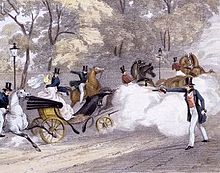 Contemporary lithograph of Edward Oxford attempting to assassinate Victoria, 1840
Contemporary lithograph of Edward Oxford attempting to assassinate Victoria, 1840
During Victoria's first pregnancy in 1840, in the first few months of the marriage, 18-year-old Edward Oxford attempted to assassinate her while she was riding in a carriage with Prince Albert on her way to visit her mother. Oxford fired twice, but both bullets missed. He was tried for high treason and found guilty, but was acquitted on the grounds of insanity.[60] In the immediate aftermath of the attack, Victoria's popularity soared, mitigating residual discontent over the Hastings affair and the bedchamber crisis.[61] Her daughter, also named Victoria, was born on 21 November 1840. The Queen hated being pregnant,[62] viewed breast-feeding with disgust,[63] and thought newborn babies were ugly.[64] Nevertheless, she and Albert had a further eight children.
Victoria's household was largely run by her childhood governess, Baroness Louise Lehzen from Hanover. Lehzen had been a formative influence on Victoria,[65] and had supported her against the Kensington System.[66] Albert, however, thought Lehzen was incompetent, and that her mismanagement threatened the health of his daughter. After a furious row between Victoria and Albert over the issue, Lehzen was pensioned off, and Victoria's close relationship with her ended.[67]
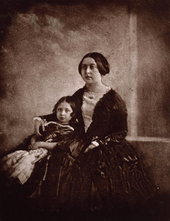 Earliest known photograph of Victoria, here with her eldest daughter, c. 1844[68]
Earliest known photograph of Victoria, here with her eldest daughter, c. 1844[68]
1842–1860
On 29 May 1842, Victoria was riding in a carriage along The Mall, London, when John Francis aimed a pistol at her but did not fire. The following day, Victoria drove the same route, though faster and with a greater escort, in a deliberate attempt to provoke Francis to take a second aim and catch him in the act. As expected, Francis shot at her, but he was seized by plain clothes policemen, and convicted of high treason. On 3 July, two days after Francis's death sentence was commuted to transportation for life, John William Bean also fired a pistol at the Queen, but it was loaded only with paper and tobacco.[69] Oxford felt that the attempts were encouraged by his acquittal in 1840. Bean was sentenced to 18 months in jail.[70] In a similar attack in 1849, unemployed Irishman William Hamilton fired a powder-filled pistol at Victoria's carriage as it passed along Constitution Hill, London.[71] In 1850, the Queen did sustain injury when she was assaulted by a possibly insane ex-army officer, Robert Pate. As Victoria was riding in a carriage, Pate struck her with his cane, crushing her bonnet and bruising her face. Both Hamilton and Pate were sentenced to seven years' transportation.[72]
Melbourne's support in the House of Commons weakened through the early years of Victoria's reign, and in the 1841 general election the Whigs were defeated. Peel became prime minister, and the Ladies of the Bedchamber most associated with the Whigs were replaced.[73]
In 1845, Ireland was hit by a potato blight.[74] In the next four years over a million Irish people died and another million emigrated in what became known as the Great Famine.[75] In Ireland, Victoria was labelled "The Famine Queen".[76][77] She personally donated £2,000 to famine relief, more than any other individual donor,[78] and also supported the Maynooth Grant to a Roman Catholic seminary in Ireland, despite Protestant opposition.[79] The story that she donated only £5 in aid to the Irish, and on the same day gave the same amount to Battersea Dogs Home, was a myth generated towards the end of the 19th century.[80]
By 1846, Peel's ministry faced a crisis involving the repeal of the Corn Laws. Many Tories—by then known also as Conservatives—were opposed to the repeal, but Peel, some Tories (the "Peelites"), most Whigs and Victoria supported it. Peel resigned in 1846, after the repeal narrowly passed, and was replaced by Lord John Russell.[81]
Victoria's British Prime Ministers Year Prime Minister (party) 1835 Lord Melbourne (Whig) 1841 Sir Robert Peel (Conservative) 1846 Lord John Russell (W) 1852 (Feb.) Lord Derby (C) 1852 (Dec.) Lord Aberdeen (Peelite) 1855 Lord Palmerston (Liberal) 1858 Derby (C) 1859 Palmerston (L) 1865 Russell (L) 1866 Derby (C) 1868 (Feb.) Benjamin Disraeli (C) 1868 (Dec.) William Ewart Gladstone (L) 1874 Disraeli (C) 1880 Gladstone (L) 1885 Lord Salisbury (C) 1886 (Feb.) Gladstone (L) 1886 (July) Salisbury (C) 1892 Gladstone (L) 1894 Lord Rosebery (L) 1895 Salisbury (C) See also List of British Prime Ministers
and, for her British and Imperial premiers,
List of Prime Ministers of Queen VictoriaInternationally, Victoria took a keen interest in the improvement of relations between France and Britain.[82] She made and hosted several visits between the British royal family and the House of Orleans, who were related by marriage through the Coburgs. In 1843 and 1845, she and Albert stayed with King Louis Philippe I at château d'Eu in Normandy; she was the first British or English monarch to visit a French one since the meeting of Henry VIII of England and Francis I of France on the Field of the Cloth of Gold in 1520.[83] When Louis Philippe made a reciprocal trip in 1844, he became the first French king to visit a British sovereign.[84] Louis Philippe was deposed in the revolutions of 1848, and fled to exile in England.[85] At the height of a revolutionary scare in the United Kingdom in April 1848, Victoria and her family left London for the greater safety of Osborne House,[86] a private estate on the Isle of Wight that they had purchased in 1845 and redeveloped.[87] Demonstrations by Chartists and Irish nationalists failed to attract widespread support, and the scare died down without any major disturbances.[88] Victoria's first visit to Ireland in 1849 was a public relations success, but it had no lasting impact or effect on the growth of Irish nationalism.[89]
Russell's ministry, though Whig, was not favoured by the Queen.[90] She found particularly offensive the Foreign Secretary, Lord Palmerston, who often acted without consulting the Cabinet, the Prime Minister, or the Queen.[91] Victoria complained to Russell that Palmerston sent official dispatches to foreign leaders without her knowledge, but Palmerston was retained in office and continued to act on his own initiative, despite her repeated remonstrances. It was only in 1851 that Palmerston was removed after he announced the British government's approval of President Louis-Napoleon Bonaparte's coup in France without consulting the Prime Minister.[92] The following year, President Bonaparte was declared Emperor Napoleon III, by which time Russell's administration had been replaced by a short-lived minority government led by Lord Derby.
In 1853, Victoria gave birth to her eighth child, Leopold, with the aid of the new anaesthetic, chloroform. Victoria was so impressed by the relief it gave from the pain of childbirth that she used it again in 1857 at the birth of her ninth and final child, Beatrice, despite opposition from members of the clergy, who considered it against biblical teaching, and members of the medical profession, who thought it dangerous.[93] Victoria may have suffered from post-natal depression after many of her pregnancies.[94] Letters from Albert to Victoria intermittently complain of her loss of self-control. For example, about a month after Leopold's birth Albert complained in a letter to Victoria about her "continuance of hysterics" over a "miserable trifle".[95]
In early 1855, the government of Lord Aberdeen, who had replaced Derby, fell amidst recriminations over the poor management of British troops in the Crimean War. Victoria approached both Derby and Russell to form a ministry, but neither had sufficient support, and Victoria was forced to appoint Palmerston as prime minister.[96]
Napoleon III, since the Crimean War Britain's closest ally,[94] visited London in April 1855, and from 17 to 28 August the same year Victoria and Albert returned the visit.[97] Napoleon III met the couple at Dunkirk and accompanied them to Paris. They visited the Exposition Universelle (a successor to Albert's 1851 brainchild the Great Exhibition) and Napoleon I's tomb at Les Invalides (to which his remains had only been returned in 1840), and were guests of honour at a 1,200-guest ball at the Palace of Versailles.[98]
On 14 January 1858, an Italian refugee from Britain called Orsini attempted to assassinate Napoleon III with a bomb made in England.[99] The ensuing diplomatic crisis destabilised the government, and Palmerston resigned. Derby was reinstated as prime minister.[100] Victoria and Albert attended the opening of a new basin at the French military port of Cherbourg on 5 August 1858, in an attempt by Napoleon III to reassure Britain that his military preparations were directed elsewhere. On her return Victoria wrote to Derby reprimanding him for the poor state of the Royal Navy in comparison to the French one.[101] Derby's ministry did not last long, and in June 1859 Victoria recalled Palmerston to office.[102]
Eleven days after Orsini's assassination attempt in France, Victoria's eldest daughter married Prince Frederick William of Prussia in London. They had been betrothed since September 1855, when Princess Victoria was 14-years-old; the marriage was delayed by the Queen and Prince Albert until the bride was 17.[103] The Queen and Albert hoped that their daughter and son-in-law would be a liberalising influence in the enlarging Prussian state.[104] Victoria felt "sick at heart" to see her daughter leave England for Germany; "It really makes me shudder", she wrote to Princess Victoria in one of her frequent letters, "when I look round to all your sweet, happy, unconscious sisters, and think I must give them up too – one by one."[105] Almost exactly a year later, Princess Victoria gave birth to the Queen's first grandchild: Wilhelm.
Widowhood
In March 1861, Victoria's mother died, with Victoria at her side. Through reading her mother's papers, Victoria discovered that her mother had loved her deeply;[106] she was heart-broken, and blamed Conroy and Lehzen for "wickedly" estranging her from her mother.[107] To relieve his wife during her intense and deep grief,[108] Albert took on most of her duties, despite being ill himself with chronic stomach trouble.[109] In August, Victoria and Albert visited their son, the Prince of Wales, who was attending army manoeuvres near Dublin, and spent a few days holiday in Killarney. In November, Albert was made aware of gossip that his son had slept with an actress in Ireland.[110] Appalled, Albert travelled to Cambridge, where his son was studying, to confront him.[111] By the beginning of December, Albert was very unwell.[112] He was diagnosed with typhoid fever by William Jenner, and died on 14 December 1861. Victoria was devastated.[113] She blamed her husband's death on worry over the Prince of Wales's philandering. He had been "killed by that dreadful business", she said.[114] She entered a state of mourning and wore black for the remainder of her life. She avoided public appearances, and rarely set foot in London in the following years.[115] Her seclusion earned her the name "widow of Windsor".[116]
Victoria's self-imposed isolation from the public diminished the popularity of the monarchy, and encouraged the growth of the republican movement.[117] She did undertake her official government duties, yet chose to remain secluded in her royal residences—Windsor Castle, Osborne House, and the private estate in Scotland that she and Albert had acquired in 1847, Balmoral Castle. In March 1864, a protester stuck a notice on the railings of Buckingham Palace that announced "these commanding premises to be let or sold in consequence of the late occupant's declining business".[118] Her uncle Leopold wrote to her advising her to appear in public. She agreed to visit the gardens of the Royal Horticultural Society at Kensington and take a drive through London in an open carriage.[119]
Through the 1860s, Victoria relied increasingly on a manservant from Scotland, John Brown.[120] Slanderous rumours of a romantic connection and even a secret marriage appeared in print, and the Queen was referred to as "Mrs Brown".[121] The story of their relationship was the subject of the 1997 movie Mrs. Brown. A painting by Edwin Landseer depicting the Queen with Brown was exhibited at the Royal Academy, and Victoria published a book, Leaves from the Journal of Our Life in the Highlands, which featured Brown prominently and in which the Queen praised him highly.[122]
Palmerston died in 1865, and after a brief ministry led by Russell, Derby returned to power. In 1866, Victoria attended the State Opening of Parliament for the first time since Albert's death.[123] The following year she supported the passing of the Reform Act 1867 which doubled the electorate by extending the franchise to many urban working men,[124] though she was not in favour of votes for women.[125] Derby resigned in 1868, to be replaced by Benjamin Disraeli, who charmed Victoria. "Everyone likes flattery," he said, "and when you come to royalty you should lay it on with a trowel."[126] With the phrase "we authors, Ma'am", he complimented her.[127] Disraeli's ministry only lasted a matter of months, and at the end of the year his Liberal rival, William Ewart Gladstone, was appointed prime minister. Victoria found Gladstone's demeanour far less appealing; he spoke to her, she was supposed to have complained, as though she was "a public meeting rather than a woman".[128]
In 1870, republican sentiment in Britain, fed by the Queen's seclusion, was boosted after the establishment of the Third French Republic.[129] A republican rally in Trafalgar Square demanded Victoria's removal, and Radical MPs spoke against her.[130] In August and September 1871, she was seriously ill with an abscess in her arm, which Joseph Lister successfully lanced and treated with his new anti-septic carbolic acid spray.[131] In late November 1871, at the height of the republican movement, the Prince of Wales contracted typhoid fever, the disease that was believed to have killed his father, and Victoria was fearful her son would die.[132] As the tenth anniversary of her husband's death approached, her son's condition grew no better, and Victoria's distress continued.[133] To general rejoicing, he pulled through.[134] Mother and son attended a public parade through London and a grand service of thanksgiving in St Paul's Cathedral on 27 February 1872, and republican feeling subsided.[135]
On the last day of February 1872, two days after the thanksgiving service, 17-year-old Arthur O'Connor (great-nephew of Irish MP Feargus O'Connor) waved an unloaded pistol at Victoria's open carriage as it drove through the gates of Buckingham Palace. Brown, who was attending the Queen, grabbed him and he was later sentenced to 12-months' imprisonment.[136] As a result of the incident, Victoria's popularity recovered further.[137]
Empress of India
After the Indian Rebellion of 1857, the British East India Company, which had ruled much of India, was dissolved, and Britain's possessions and protectorates on the Indian subcontinent were formally incorporated into the British Empire. The Queen had a relatively balanced view of the conflict, and condemned atrocities on both sides.[138] She wrote of "her feelings of horror and regret at the result of this bloody civil war",[139] and insisted, urged on by Albert, that an official proclamation announcing the transfer of power from the company to the state "should breathe feelings of generosity, benevolence and religious toleration".[140] At her behest, a reference threatening the "undermining of native religions and customs" was replaced by a passage guaranteeing religious freedom.[140]
In the 1874 general election, Disraeli was returned to power. He passed the Public Worship Regulation Act 1874, which removed Catholic rituals from the Anglican liturgy and which Victoria strongly supported.[141] She preferred short, simple services, and personally considered herself more aligned with the Presbyterian Church of Scotland than the Episcopalian Church of England.[142] He also pushed the Royal Titles Act 1876 through Parliament, so that Victoria took the title "Empress of India" from 1 May 1876.[143] The new title was proclaimed at the Delhi Durbar of 1 January 1877.[144]
On 14 December 1878, the anniversary of Albert's death, Victoria's second daughter Alice, who had married Louis of Hesse, died of diphtheria in Darmstadt. Victoria noted the coincidence of the dates as "almost incredible and most mysterious".[145] In May 1879, she became a great-grandmother (on the birth of Princess Feodora of Saxe-Meiningen) and passed her "poor old 60th birthday". She felt "aged" by "the loss of my beloved child".[146]
Between April 1877 and February 1878, she threatened five times to abdicate while pressuring Disraeli to act against Russia during the Russo-Turkish War, but her threats had no impact on the events or their conclusion with the Congress of Berlin.[147] Disraeli's expansionist foreign policy, which Victoria endorsed, led to conflicts such as the Anglo-Zulu War and the Second Anglo-Afghan War. "If we are to maintain our position as a first-rate Power", she wrote, "we must … be Prepared for attacks and wars, somewhere or other, CONTINUALLY."[148] Victoria saw the expansion of the British Empire as civilising and benign, protecting native peoples from more aggressive powers or cruel rulers: "It is not in our custom to annexe countries", she said, "unless we are obliged & forced to do so."[149] To Victoria's dismay, Disraeli lost the 1880 general election, and Gladstone returned as prime minister.[150] When Disraeli died the following year, she was blinded by "fast falling tears",[151] and erected a memorial tablet "placed by his grateful Sovereign and Friend, Victoria R.I."[152]
Later years
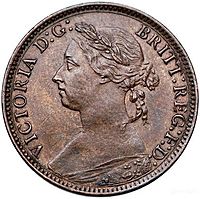 Victorian farthing, 1885
Victorian farthing, 1885
On 2 March 1882, Roderick Maclean, a disgruntled poet apparently offended by Victoria's refusal to accept one of his poems,[153] shot at the Queen as her carriage left Windsor railway station. Two schoolboys from Eton College struck him with their umbrellas, until he was hustled away by a policeman.[154] Victoria was outraged when he was found not guilty by reason of insanity,[155] but was so pleased by the many expressions of loyalty after the attack that she said it was "worth being shot at—to see how much one is loved".[156]
On 17 March 1883, she fell down some stairs at Windsor, which left her lame until July; she never fully recovered and was plagued with rheumatism thereafter.[157] Brown died 10 days after her accident, and to the consternation of her private secretary, Sir Henry Ponsonby, Victoria began work on a eulogistic biography of Brown.[158] Ponsonby and Randall Davidson, Dean of Windsor, who had both seen early drafts, advised Victoria against publication, on the grounds that it would stoke the rumours of a love affair.[159] The manuscript was destroyed.[160] In early 1884, Victoria did publish More Leaves from a Journal of a Life in the Highlands, a sequel to her earlier book, which she dedicated to her "devoted personal attendant and faithful friend John Brown".[161] On the day after the first anniversary of Brown's death, Victoria was informed by telegram that her youngest son, Leopold, had died in Cannes. He was "the dearest of my dear sons", she lamented.[162] The following month, Victoria's youngest child, Beatrice, met and fell in love with Prince Henry of Battenberg at the wedding of Victoria's granddaughter Princess Victoria of Hesse and by Rhine to Henry's brother Prince Louis of Battenberg. Beatrice and Henry planned to marry, but Victoria opposed the match at first, wishing to keep Beatrice at home to act as her companion. After a year, she was won around to the marriage by Henry and Beatrice's promise to remain living with and attending her.[163]
Victoria was pleased when Gladstone resigned in 1885 after his budget was defeated.[164] She thought his government was "the worst I have ever had", and blamed him for the death of General Gordon at Khartoum.[165] Gladstone was replaced by Lord Salisbury. Salisbury's government only lasted a few months, however, and Victoria was forced to recall Gladstone, whom she referred to as a "half crazy & really in many ways ridiculous old man".[166] Gladstone attempted to pass a bill granting Ireland home rule, but to Victoria's glee it was defeated.[167] In the ensuing election, Gladstone's party lost to Salisbury's and the government switched hands again.
Golden Jubilee
In 1887, the British Empire celebrated Victoria's Golden Jubilee. Victoria marked the fiftieth anniversary of her accession on 20 June with a banquet to which 50 kings and princes were invited. The following day, she participated in a procession that, in the words of Mark Twain, "stretched to the limit of sight in both directions" and attended a thanksgiving service in Westminster Abbey.[168] By this time, Victoria was once again extremely popular.[169] Two days later on 23 June,[170] she engaged two Indian Muslims as waiters, one of whom was Abdul Karim. He was soon promoted to "Munshi": teaching her Hindi-Urdu, and acting as a clerk.[171] Her family and retainers were appalled, and accused Abdul Karim of spying for the Muslim Patriotic League, and biasing the Queen against the Hindus.[172] Equerry Frederick Ponsonby (the son of Sir Henry) discovered that the Munshi had lied about his parentage, and reported to Lord Elgin, Viceroy of India, "the Munshi occupies very much the same position as John Brown used to do."[173] Victoria dismissed their complaints as racial prejudice.[174] Abdul Karim remained in her service until he returned to India with a pension on her death.[175]
Victoria's eldest daughter became Empress consort of Germany in 1888, but she was widowed within the year, and Victoria's grandchild Wilhelm became German Emperor as Wilhelm II. Under Wilhelm, Victoria and Albert's hopes of a liberal Germany were not fulfilled. He believed in autocracy. Victoria thought he had "little heart or Zartgefühl [tact] – and ... his conscience & intelligence have been completely wharped [sic]".[176]
Gladstone returned to power aged over 82 after the 1892 general election. Victoria objected when Gladstone proposed appointing the Radical MP Henry Labouchere to the Cabinet, and so Gladstone agreed not to appoint him.[177] In 1894, Gladstone retired and, without consulting the outgoing prime minister, Victoria appointed Lord Rosebery as prime minister.[178] His government was weak, and the following year Lord Salisbury replaced him. Salisbury remained prime minister for the remainder of Victoria's reign.[179]
Diamond Jubilee
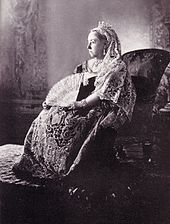 Queen Victoria in her Diamond Jubilee photograph (London, 1897)
Queen Victoria in her Diamond Jubilee photograph (London, 1897)
On 23 September 1896, Victoria surpassed George III as the longest-reigning monarch in English, Scottish, and British history. The Queen requested that any special celebrations be delayed until 1897, to coincide with her Diamond Jubilee,[180] which was made a festival of the British Empire at the suggestion of Colonial Secretary Joseph Chamberlain.[181]
The prime ministers of all the self-governing dominions were invited, and the Queen's Diamond Jubilee procession through London included troops from all over the empire. The parade paused for an open-air service of thanksgiving held outside St Paul's Cathedral, throughout which Victoria sat in her open carriage. The celebration was marked by great outpourings of affection for the septuagenarian Queen.[182]
Victoria visited mainland Europe regularly for holidays. In 1889, during a stay in Biarritz, she became the first reigning monarch from Britain to set foot in Spain when she crossed the border for a brief visit.[183] By April 1900, the Boer War was so unpopular in mainland Europe that her annual trip to France seemed inadvisable. Instead, the Queen went to Ireland for the first time since 1861, in part to acknowledge the contribution of Irish regiments to the South African war.[184] In July, her second son Alfred ("Affie") died; "Oh, God! My poor darling Affie gone too", she wrote in her journal. "It is a horrible year, nothing but sadness & horrors of one kind & another."[185]
Death and succession
Following a custom she maintained throughout her widowhood, Victoria spent the Christmas of 1900 at Osborne House on the Isle of Wight. Rheumatism in her legs had rendered her lame, and her eyesight was clouded by cataracts.[186] Through early January, she felt "weak and unwell",[187] and by mid-January she was "drowsy ... dazed, [and] confused".[188] She died on Tuesday 22 January 1901 at half past six in the evening, at the age of 81.[189] Her son, the future King Edward VII, and her eldest grandson, Kaiser Wilhelm II of Germany, were at her deathbed.[190]
In 1897, Victoria had written instructions for her funeral, which was to be military as befitting a soldier's daughter and the head of the army,[94] and white instead of black.[191] On 25 January, Edward VII, the Kaiser and Prince Arthur, Duke of Connaught, helped lift her into the coffin.[192] She was dressed in a white dress and her wedding veil.[193] An array of mementos commemorating her extended family, friends and servants were laid in the coffin with her, at her request, by her doctor and dressers. One of Albert's dressing gowns was placed by her side, with a plaster cast of his hand, while a lock of Brown's hair, along with a picture of him, were placed in her left hand concealed from the view of the family by a carefully positioned bunch of flowers.[94][194] Items of jewellery placed on Victoria included the wedding ring of John Brown's mother, given to her by Brown in 1883.[94] Her funeral was held on Saturday 2 February in St. George's Chapel, Windsor Castle, and after two days of lying-in-state, she was interred beside Prince Albert in Frogmore Mausoleum at Windsor Great Park. As she was laid to rest at the mausoleum, it began to snow.[195]
Victoria is the longest-reigning British monarch and the longest-reigning Queen regnant in world history; she reigned for a total of 63 years, seven months and two days. She was the last monarch of Britain from the House of Hanover. Her son and heir Edward VII belonged to her husband's House of Saxe-Coburg and Gotha.
Legacy
See also: Cultural depictions of Queen VictoriaAccording to one of her biographers, Giles St Aubyn, Victoria wrote an average of 2500 words a day during her adult life.[199] From July 1832 until just before her death, she kept a detailed journal, which eventually encompassed 122 volumes.[200] After Victoria's death, her youngest daughter Princess Beatrice, was appointed her literary executor. Beatrice transcribed and edited the diaries covering Victoria's accession onwards, and burned the originals in the process.[201] Despite this destruction, much of the diaries still exist. In addition to Beatrice's edited copy, Lord Esher transcribed the volumes from 1832 to 1861 before Beatrice destroyed them.[202] Part of Victoria's extensive correspondence has been published in volumes edited by A. C. Benson, Hector Bolitho, George Earle Buckle, Lord Esher, Roger Fulford, and Richard Hough among others.[203]
Victoria was physically unprepossessing—she was stout, dowdy and no more than five feet tall—but she succeeded in projecting a grand image.[204] She experienced unpopularity during the first years of her widowhood, but was well liked during the 1880s and 1890s, when she embodied the empire as a benevolent matriarchal figure.[205] Only after the release of her diary and letters did the extent of her political influence become known to the wider public.[94][206] Biographies of Victoria written before much of the primary material became available, such as Lytton Strachey's Queen Victoria of 1921, are now considered out of date.[207] The biographies written by Elizabeth Longford and Cecil Woodham-Smith, in 1964 and 1972 respectively, are still widely admired.[208] They, and others, conclude that as a person Victoria was emotional, obstinate, honest, and straight-talking.[209]
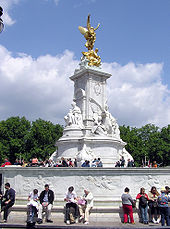 The Victoria Memorial in front of Buckingham Palace was erected as part of the remodelling of the façade of the Palace a decade after her death.
The Victoria Memorial in front of Buckingham Palace was erected as part of the remodelling of the façade of the Palace a decade after her death.
Through Victoria's reign, the gradual establishment of a modern constitutional monarchy in Britain continued. Reforms of the voting system increased the power of the House of Commons at the expense of the House of Lords and the monarch.[210] In 1867, Walter Bagehot wrote that the monarch only retained "the right to be consulted, the right to encourage, and the right to warn".[211] As Victoria's monarchy became more symbolic than political, it placed a strong emphasis on morality and family values, in contrast to the sexual, financial and personal scandals that had been associated with previous members of the House of Hanover and which had discredited the monarchy. The concept of the "family monarchy", with which the burgeoning middle classes could identify, was solidified.[212]
 Map of the British Empire under Queen Victoria at the end of the nineteenth century
Map of the British Empire under Queen Victoria at the end of the nineteenth century
Victoria's links with Europe's royal families earned her the nickname "the grandmother of Europe".[213] Victoria and Albert had 42 grandchildren, of whom 34 survived to adulthood. Their descendants include Elizabeth II, Prince Philip, Duke of Edinburgh, Harald V of Norway, Carl XVI Gustaf of Sweden, Margrethe II of Denmark, Juan Carlos I and Queen Sofía of Spain.
One of Victoria's children, her youngest son, Leopold, was affected by the blood-clotting disease haemophilia B and two of her five daughters, Alice and Beatrice, were carriers. Royal haemophiliacs descended from Victoria included her great-grandsons, Tsarevich Alexei of Russia, Alfonso, Prince of Asturias, and Infante Gonzalo of Spain.[214] The presence of the disease in Victoria's descendants, but not in her ancestors, led to modern speculation that her true father was not the Duke of Kent but a haemophiliac.[215] There is no documentary evidence of a haemophiliac in connection with Victoria's mother, and as male carriers always suffer the disease, even if such a man had existed he would have been seriously ill.[216] It is more likely that the mutation arose spontaneously because Victoria's father was old at the time of her conception and haemophilia arises more frequently in the children of older fathers.[217] Spontaneous mutations account for about 30% of cases.[218]
Around the world, places and memorials are dedicated to her, especially in the Commonwealth nations. Places named after her, include the capital of the Seychelles, Africa's largest lake, Victoria Falls, the capitals of British Columbia (Victoria) and Saskatchewan (Regina), and two Australian states (Victoria and Queensland).
The Victoria Cross was introduced in 1856 to reward acts of valour during the Crimean War, and it remains the highest British, Canadian, Australian, and New Zealand award for bravery. Victoria Day is a Canadian statutory holiday and a local public holiday in parts of Scotland celebrated on the last Monday before or on 24 May (Queen Victoria's birthday).
Titles, styles, and arms
Titles and styles
- 24 May 1819 – 20 June 1837: Her Royal Highness Princess Alexandrina Victoria of Kent
- 20 June 1837 – 22 January 1901: Her Majesty The Queen
- 1 May 1876 – 22 January 1901: Her Imperial Majesty The Queen-Empress
At the end of her reign, the Queen's full style and title were: "Her Majesty Victoria, by the Grace of God, of the United Kingdom of Great Britain and Ireland Queen, Defender of the Faith, Empress of India."[219]
Arms
Main article: Royal coat of arms of the United KingdomBefore her accession, Victoria received no grant of arms. As she could not succeed to the throne of Hanover, her arms as Sovereign did not carry the Hanoverian symbols that were used by her predecessors. Her arms have been borne by all of her successors on the throne, including the present Queen.
Outside Scotland, the shield of Victoria's coat of arms—also used on her Royal Standard—was: Quarterly: I and IV, Gules, three lions passant guardant in pale Or (for England); II, Or, a lion rampant within a double tressure flory-counter-flory Gules (for Scotland); III, Azure, a harp Or stringed Argent (for Ireland). Within Scotland, the first and fourth quarters are occupied by the Scottish lion, and the second by the English lions. The Lion and the Unicorn supporters also differ between Scotland and the rest of the United Kingdom.[220]
Royal arms (outside Scotland)Royal arms in ScotlandIssue
See also: Grandchildren of Victoria and Albert and Royal descendants of Queen Victoria and King Christian IX Queen Victoria's family in 1846 by Franz Xaver Winterhalter left to right: Prince Alfred and the Prince of Wales; the Queen and Prince Albert; Princesses Alice, Helena and Victoria
Queen Victoria's family in 1846 by Franz Xaver Winterhalter left to right: Prince Alfred and the Prince of Wales; the Queen and Prince Albert; Princesses Alice, Helena and Victoria
Name Birth Death Spouse (years of birth & death) and children[219][221] The Princess Victoria,
Princess Royal21 November
18405 August
1901Married 1858, Prussian Crown Prince Frederick, later Frederick III, German Emperor and King of Prussia (1831–1888);
4 sons, 4 daughters (including Wilhelm II, German Emperor and Sophia, Queen of Greece)The Prince Albert Edward,
Prince of Wales,
later King Edward VII9 November
18416 May
1910Married 1863, Princess Alexandra of Denmark (1844–1925);
3 sons, 3 daughters (including King George V and Maud, Queen of Norway)The Princess Alice 25 April
184314 December
1878Married 1862, Louis IV, Grand Duke of Hesse and by Rhine (1837–1892);
2 sons, 5 daughters (including Alexandra, Empress of Russia)The Prince Alfred,
Duke of Saxe-Coburg and Gotha
and Duke of Edinburgh;
Admiral of the Fleet6 August
184431 July
1900Married 1874, Grand Duchess Maria Alexandrovna of Russia
(1853–1920);
2 sons (1 still-born), 4 daughters (including Marie, Queen of Romania)The Princess Helena 25 May
18469 June
1923Married 1866, Prince Christian of Schleswig-Holstein-Sonderburg-Augustenburg (1831–1917);
4 sons (1 still-born), 2 daughtersThe Princess Louise 18 March
18483 December
1939Married 1871, John Douglas Sutherland Campbell (1845–1914),
Marquess of Lorne, later 9th Duke of Argyll,
also Governor-General of Canada (1878–83);
no issueThe Prince Arthur,
Duke of Connaught and Strathearn;
Field Marshal,
Governor General of Canada (1911–1916)1 May
185016 January
1942Married 1879, Princess Louise Margaret of Prussia (1860–1917);
1 son, 2 daughtersThe Prince Leopold,
Duke of Albany7 April
185328 March
1884Married 1882, Princess Helena of Waldeck and Pyrmont (1861–1922);
1 son, 1 daughterThe Princess Beatrice 14 April
185726 October
1944Married 1885, Prince Henry of Battenberg (1858–1896);
3 sons, 1 daughter (including Victoria Eugenie, Queen of Spain)Ancestry
Notes and references
- ^ Hibbert, pp. 3–12; Strachey, pp. 1–17; Woodham-Smith, pp. 15–29
- ^ Her godparents were Emperor Alexander I of Russia (represented by her uncle the Duke of York), her uncle the Prince Regent, her aunt Queen Charlotte of Württemberg (represented by Victoria's aunt Princess Augusta) and Victoria's maternal grandmother the Dowager Duchess of Saxe-Coburg-Saalfeld (represented by Victoria's aunt Princess Mary, Duchess of Gloucester and Edinburgh).
- ^ Hibbert, pp. 12–13; Woodham-Smith, pp. 34–35
- ^ Longford, p. 24
- ^ Hibbert, p. 31; St Aubyn, p. 26; Woodham-Smith, p. 81
- ^ Hibbert, p. 46; Longford, p. 54; St Aubyn, p. 50; Waller, p. 344; Woodham-Smith, p. 126
- ^ Hibbert, p. 19; Marshall, p. 25
- ^ Hibbert, p. 27; Longford, pp. 35–38, 118–119; St Aubyn, pp. 21–22; Woodham-Smith, pp. 70–72. The rumours were false in the opinion of these biographers.
- ^ Hibbert, pp. 27–28; Waller, pp. 341–342; Woodham-Smith, pp. 63–65
- ^ Hibbert, pp. 32–33; Longford, pp. 38–39, 55; Marshall, p. 19
- ^ Lacey, Robert (2006) Great Tales from English History, Volume 3, London: Little, Brown, and Company, ISBN 0-316-11459-6, pp. 133–136
- ^ Waller, pp. 338–341; Woodham-Smith, pp. 68–69, 91
- ^ Hibbert, p. 18; Longford, p. 31; Woodham-Smith, pp. 74–75
- ^ Longford, p. 31; Woodham-Smith, p. 75
- ^ Hibbert, pp. 34–35
- ^ Hibbert, pp. 35–39; Woodham-Smith, pp. 88–89, 102
- ^ Hibbert, p. 36; Woodham-Smith, pp. 89–90
- ^ Hibbert, pp. 35–40; Woodham-Smith, pp. 92, 102
- ^ Hibbert, pp. 38–39; Longford, p. 47; Woodham-Smith, pp. 101–102
- ^ Hibbert, p. 42; Woodham-Smith, p. 105
- ^ Hibbert, p. 42; Longford, pp. 47–48; Marshall, p. 21
- ^ Hibbert, pp. 42, 50; Woodham-Smith, p. 135
- ^ Marshall, p. 46; St Aubyn, p. 67; Waller, p. 353
- ^ Longford, pp. 29, 51; Waller, p. 363; Weintraub, pp. 43–49
- ^ Longford, p. 51; Weintraub, pp. 43–49
- ^ Longford, pp. 51–52; St Aubyn, p. 43; Weintraub, pp. 43–49; Woodham-Smith, p. 117
- ^ Weintraub, pp. 43–49
- ^ Victoria quoted in Weintraub, p. 49 and Marshall, p. 27
- ^ Victoria quoted in Hibbert, p. 99; St Aubyn, p. 43; Weintraub, p. 49 and Woodham-Smith, p. 119
- ^ Victoria's journal, October 1835, quoted in St Aubyn, p. 36 and Woodham-Smith, p. 104
- ^ Hibbert, p. 102; Marshall, p. 60; Waller, p. 363; Weintraub, p. 51; Woodham-Smith, p. 122
- ^ Waller, pp. 363–364; Weintraub, pp. 53, 58, 64, and 65
- ^ St Aubyn, pp. 55–57; Woodham-Smith, p. 138
- ^ Woodham-Smith, p. 140
- ^ Packard, pp. 14–15
- ^ Hibbert, pp. 66–69; St Aubyn, p. 76; Woodham-Smith, pp. 143–147
- ^ Greville quoted in Hibbert, p. 67; Longford, p. 70 and Woodham-Smith, p. 143–144
- ^ St Aubyn, p. 69; Waller, p. 353
- ^ Hibbert, p. 58; Longford, pp. 73–74; Woodham-Smith, p. 152
- ^ Marshall, p. 42; St Aubyn, pp. 63, 96
- ^ Marshall, p. 47; Waller, p. 356; Woodham-Smith, pp. 164–166
- ^ Hibbert, pp. 77–78; Longford, p. 97; St Aubyn, p. 97; Waller, p. 357; Woodham-Smith, p. 164
- ^ Victoria's journal, 25 April 1838, quoted in Woodham-Smith, p. 162
- ^ St Aubyn, p. 96; Woodham-Smith, pp. 162, 165
- ^ Hibbert, p. 79; Longford, p. 98; St Aubyn, p. 99; Woodham-Smith, p. 167
- ^ Hibbert, pp. 80–81; Longford, pp. 102–103; St Aubyn, pp. 101–102
- ^ Longford, p. 122; Marshall, p. 57; St Aubyn, p. 104; Woodham-Smith, p. 180
- ^ Hibbert, p. 83; Longford, pp. 120–121; Marshall, p. 57; St Aubyn, p. 105; Waller, p. 358
- ^ St Aubyn, p. 107; Woodham-Smith, p. 169
- ^ Hibbert, pp. 94–96; Marshall, pp. 53–57; St Aubyn, pp. 109–112; Waller, pp. 359–361; Woodham-Smith, pp. 170–174
- ^ Longford, p. 84; Marshall, p. 52
- ^ Longford, p. 72; Waller, p. 353
- ^ Woodham-Smith, p. 175
- ^ Hibbert, pp. 103–104; Marshall, pp. 60–66; Weintraub, p. 62
- ^ Hibbert, pp. 107–110; St Aubyn, pp. 129–132; Weintraub, pp. 77–81; Woodham-Smith, pp. 182–184, 187
- ^ Hibbert, p. 123; Longford, p. 143; Woodham-Smith, p. 205
- ^ St Aubyn, p. 151
- ^ Hibbert, p. 265, Woodham-Smith, p. 256
- ^ Marshall, p. 152; St Aubyn, pp. 174–175; Woodham-Smith, p. 412
- ^ Hibbert, pp. 421–422; St Aubyn, pp. 160–161
- ^ Woodham-Smith, p. 213
- ^ Hibbert, pp. 130; Longford, p. 154; Marshall, p. 122; St Aubyn, p. 159; Woodham-Smith, p. 220
- ^ Hibbert, p. 149; St Aubyn, p. 169
- ^ Hibbert, p. 149; Longford, p. 154; Marshall, p. 123; Waller, p. 377
- ^ Woodham-Smith, p. 100
- ^ Longford, p. 56; St Aubyn, p. 29
- ^ Hibbert, pp. 150–156; Marshall, p. 87; St Aubyn, pp. 171–173; Woodham-Smith, pp. 230–232
- ^ Queen Victoria and the Princess Royal, Royal Collection, http://www.royalcollection.org.uk/eGallery/object.asp?searchText=2931317%2Ec&x=5&y=15&object=2931317c&row=0&detail=about, retrieved 30 July 2010
- ^ Hibbert, pp. 422–423; St Aubyn, pp. 162–163
- ^ Hibbert, p. 423; St Aubyn, p. 163
- ^ Longford, p. 192
- ^ St Aubyn, p. 164
- ^ Marshall, pp. 95–101; St Aubyn, pp. 153–155; Woodham-Smith, pp. 221–222
- ^ Woodham-Smith, p. 281
- ^ Longford, p. 359
- ^ The title of Maud Gonne's 1900 article upon Queen Victoria's visit to Ireland
- ^ "Famine Queen row in Irish port", BBC News, 15 April 2003, http://news.bbc.co.uk/1/hi/northern_ireland/2951395.stm, retrieved 9 April 2010
- ^ Kinealy, Christine, Private Responses to the Famine, University College Cork, http://multitext.ucc.ie/d/Private_Responses_to_the_Famine3344361812, retrieved 27 October 2010
- ^ Longford, p. 181
- ^ Kenny, Mary (2009) Crown and Shamrock: Love and Hate Between Ireland and the British Monarchy, Dublin: New Island, ISBN 190549498X
- ^ St Aubyn, p. 215
- ^ St Aubyn, p. 238
- ^ Longford, pp. 175, 187; St Aubyn, pp. 238, 241; Woodham-Smith, pp. 242, 250
- ^ Woodham-Smith, p. 248
- ^ Hibbert, p. 198; Longford, p. 194; St Aubyn, p. 243; Woodham-Smith, pp. 282–284
- ^ Hibbert, pp. 201–202; Marshall, p. 139; St Aubyn, pp. 222–223; Woodham-Smith, pp. 287–290
- ^ Hibbert, pp. 161–164; Marshall, p. 129; St Aubyn, pp. 186–190; Woodham-Smith, pp. 274–276
- ^ Longford, pp. 196–197; St Aubyn, p. 223; Woodham-Smith, pp. 287–290
- ^ Longford, p. 191; Woodham-Smith, p. 297
- ^ St Aubyn, p. 216
- ^ Hibbert, pp. 196–198; St Aubyn, p. 244; Woodham-Smith, pp. 298–307
- ^ Hibbert, pp. 204–209; Marshall, pp. 108–109; St Aubyn, pp. 244–254; Woodham-Smith, pp. 298–307
- ^ Hibbert, pp. 216–217; St Aubyn, pp. 257–258
- ^ a b c d e f g Matthew, H. C. G.; Reynolds, K. D. (2004; online edition October 2009) "Victoria (1819–1901)", Oxford Dictionary of National Biography, Oxford University Press, doi:10.1093/ref:odnb/36652, retrieved 18 October 2010 (subscription required for online access)
- ^ Hibbert, pp. 217–220; Woodham-Smith, pp. 328–331
- ^ Hibbert, pp. 227–228; Longford, pp. 245–246; St Aubyn, p. 297; Woodham-Smith, pp. 354–355
- ^ Woodham-Smith, pp. 357–360
- ^ 1855 visit of Queen Victoria, Château de Versailles, http://en.chateauversailles.fr/history/the-significant-dates/most-important-dates/1855-visit-of-queen-victoria, retrieved 9 March 2011
- ^ Hibbert, pp. 241–242; Longford, pp. 280–281; St Aubyn, p. 304; Woodham-Smith, p. 391
- ^ Hibbert, p. 242; Longford, p. 281; Marshall, p. 117
- ^ Napoleon III Receiving Queen Victoria at Cherbourg, 5 August 1858, National Maritime Museum, http://www.nmm.ac.uk/collections/explore/object.cfm?ID=BHC0637, retrieved 9 March 2011
- ^ Hibbert, p. 255; Marshall, p. 117
- ^ Longford, pp. 259–260; Weintraub, pp. 326 ff.
- ^ Longford, p. 263; Weintraub, pp. 326, 330
- ^ Hibbert, p. 244
- ^ Hibbert, p. 267; Longford, pp. 118, 290; St Aubyn, p. 319; Woodham-Smith, p. 412
- ^ Hibbert, p. 267; Marshall, p. 152; Woodham-Smith, p. 412
- ^ Hibbert, pp. 265–267; St Aubyn, p. 318; Woodham-Smith, pp. 412–413
- ^ Waller, p. 393; Weintraub, p. 401
- ^ Hibbert, p. 274; Longford, p. 293; St Aubyn, p. 324; Woodham-Smith, p. 417
- ^ Longford, p. 293; Marshall, p. 153; Strachey, p. 214
- ^ Hibbert, pp. 276–279; St Aubyn, p. 325; Woodham-Smith, pp. 422–423
- ^ Hibbert, pp. 280–292; Marshall, p. 154
- ^ Hibbert, p. 299; St Aubyn, p. 346
- ^ St Aubyn, p. 343
- ^ e.g. Strachey, p. 306
- ^ Marshall, pp. 170–172; St Aubyn, p. 385
- ^ Hibbert, p. 310; Longford, p. 321; St Aubyn, pp. 343–344; Waller, p. 404
- ^ Hibbert, p. 310; Longford, p. 322
- ^ Hibbert, pp. 323–324; Marshall, pp. 168–169; St Aubyn, p. 356–362
- ^ Hibbert, pp. 321–322; Longford, pp. 327–328; Marshall, p. 170
- ^ Hibbert, p. 329; St Aubyn, pp. 361–362
- ^ Hibbert, pp. 311–312; Longford, p. 347; St Aubyn, p. 369
- ^ St Aubyn, pp. 374–375
- ^ Marshall, p. 199; Strachey, p. 299
- ^ Hibbert, p. 318; Longford, p. 401; St Aubyn, p. 427; Strachey, p. 254
- ^ Buckle, George Earle; Monypenny, W. F. (1910–20) The Life of Benjamin Disraeli, Earl of Beaconsfield, vol. 5, p. 49, quoted in Strachey, p. 243
- ^ Hibbert, p. 320; Strachey, pp. 246–247
- ^ Longford, p. 381; St Aubyn, pp. 385–386; Strachey, p. 248
- ^ St Aubyn, pp. 385–386; Strachey, pp. 248–250
- ^ Longford, p. 385
- ^ Hibbert, p. 343
- ^ Hibbert, pp. 343–344; Longford, p. 389; Marshall, p. 173
- ^ Hibbert, pp. 344–345
- ^ Hibbert, p. 345; Longford, pp. 390–391; Marshall, p. 176; St Aubyn, p. 388
- ^ Hibbert, pp. 426–427; St Aubyn, pp. 388–389
- ^ Hibbert, p. 427; Marshall, p. 176; St Aubyn, p. 389
- ^ Hibbert, pp. 249–250; Woodham-Smith, pp. 384–385
- ^ Woodham-Smith, p. 386
- ^ a b Hibbert, p. 251; Woodham-Smith, p. 386
- ^ Hibbert, p. 361; Longford, p. 402; Marshall, pp. 180–184; Waller, p. 423
- ^ Hibbert, pp. 295–296; Waller, p. 423
- ^ Hibbert, p. 361; Longford, pp. 405–406; Marshall, p. 184; St Aubyn, p. 434; Waller, p. 426
- ^ Waller, p. 427
- ^ Victoria's diary and letters quoted in Longford, p. 425
- ^ Victoria quoted in Longford, p. 426
- ^ Longford, pp. 412–413
- ^ Longford, p. 426
- ^ Longford, p. 411
- ^ Hibbert, pp. 367–368; Longford, p. 429; Marshall, p. 186; St Aubyn, pp. 442–444; Waller, pp. 428–429
- ^ Letter from Victoria to Montagu Corry, 1st Baron Rowton, quoted in Hibbert, p. 369
- ^ Longford, p. 437
- ^ Hibbert, p. 420; St Aubyn, p. 422
- ^ Hibbert, p. 420; St Aubyn, p. 421
- ^ Hibbert, pp. 420–421; St Aubyn, p. 422; Strachey, p. 278
- ^ Hibbert, p. 427; Longford, p. 446; St Aubyn, p. 421
- ^ Longford, pp. 451–452
- ^ Longford, p. 454; St Aubyn, p. 425; Hibbert, p. 443
- ^ Hibbert, pp. 443–444; St Aubyn, pp. 425–426
- ^ Hibbert, pp. 443–444; Longford, p. 455
- ^ Hibbert, p. 444; St Aubyn, p. 424; Waller, p. 413
- ^ Longford, p. 461
- ^ Longford, pp. 477–478
- ^ Hibbert, p. 373; St Aubyn, p. 458
- ^ Waller, p. 433; see also Hibbert, pp. 370–371 and Marshall, pp. 191–193
- ^ Hibbert, p. 373; Longford, p. 484
- ^ Hibbert, p. 374; Longford, p. 491; Marshall, p. 196; St Aubyn, pp. 460–461
- ^ Queen Victoria, Royal Household, http://www.royal.gov.uk/HMTheQueen/TheQueenandspecialanniversaries/HistoryofJubilees/QueenVictoria.aspx, retrieved 26 February 2011
- ^ Marshall, pp. 210–211; St Aubyn, pp. 491–493
- ^ Longford, p. 502
- ^ Hibbert, pp. 447–448; Longford, p. 508; St Aubyn, p. 502; Waller, p. 441
- ^ Hibbert, pp. 448–449
- ^ Hibbert, pp. 449–451
- ^ Hibbert, p. 447; Longford, p. 539; St Aubyn, p. 503; Waller, p. 442
- ^ Hibbert, p. 454
- ^ Hibbert, p. 382
- ^ Hibbert, p. 375; Longford, p. 519
- ^ Hibbert, p. 376; Longford, p. 530; St Aubyn, p. 515
- ^ Hibbert, p. 377
- ^ Hibbert, p. 456
- ^ Longford, p. 546; St Aubyn, pp. 545–546
- ^ Hibbert, pp. 457–458; Marshall, pp. 206–207, 211; St Aubyn, pp. 546–548
- ^ Hibbert, p. 436; St Aubyn, p. 508
- ^ Hibbert, pp. 437–438; Longford, pp. 554–555; St Aubyn, p. 555
- ^ Longford, p. 558
- ^ Hibbert, pp. 464–466, 488–489; Strachey, p. 308; Waller, p. 442
- ^ Victoria's journal, 1 January 1901, quoted in Hibbert, p. 492; Longford, p. 559 and St Aubyn, p. 592
- ^ Her personal physician Sir James Reid, quoted in Hibbert, p. 492
- ^ Longford, p. 562
- ^ Longford, p. 561; St Aubyn, p. 598
- ^ Hibbert, p. 497; Longford, p. 563
- ^ St Aubyn, p. 598
- ^ Longford, p. 563
- ^ Hibbert, p. 498
- ^ Longford, p. 565; St Aubyn, p. 600
- ^ Fulford, Roger (1967) "Victoria", Collier's Encyclopedia, United States: Crowell, Collier and Macmillan Inc., vol. 23, p. 127
- ^ Ashley, Mike (1998) British Monarchs, London: Robinson, ISBN 1841190969, p. 690
- ^ Example from a letter written by lady-in-waiting Marie Mallet née Adeane, quoted in Hibbert, p. 471
- ^ Hibbert, p. xv; St Aubyn, p. 340
- ^ St Aubyn, p. 30; Woodham-Smith, p. 87
- ^ Hibbert, pp. 503–504; St Aubyn, p. 30; Woodham-Smith, pp. 88, 436–437
- ^ Hibbert, p. 503
- ^ Hibbert, pp. 503–504; St Aubyn, p. 624
- ^ Hibbert, pp. 61–62; Longford, pp. 89, 253; St Aubyn, pp. 48, 63–64
- ^ Marshall, p. 210; Waller, pp. 419, 434–435, 443
- ^ Waller, p. 439
- ^ St Aubyn, p. 624
- ^ Hibbert, p. 504; St Aubyn, p. 623
- ^ e.g. Hibbert, p. 352; Strachey, p. 304; Woodham-Smith, p. 431
- ^ Waller, p. 429
- ^ Bagehot, Walter (1867) The English Constitution, London:Chapman and Hall, p. 103
- ^ St Aubyn, pp. 602–603; Strachey, pp. 303–304; Waller, pp. 366, 372, 434
- ^ Erickson, Carolly (1997) Her Little Majesty: The Life of Queen Victoria, New York: Simon & Schuster, ISBN 0-7432-3657-2
- ^ Rogaev, Evgeny I. et al. (2009) "Genotype Analysis Identifies the Cause of the 'Royal Disease'", Science, vol. 326, no. 5954, p. 817, doi:10.1126/science.1180660, retrieved 13 October 2010
- ^ Potts and Potts, pp. 55–65, quoted in Hibbert p. 217; Packard, pp. 42–43
- ^ Jones, Steve (1996) In the Blood, BBC documentary
- ^ McKusick, Victor A. (1965) "The Royal Hemophilia", Scientific American, vol. 213, p. 91; Jones, Steve (1993) The Language of the Genes, London: HarperCollins, ISBN 0-00-255020-2, p. 69; Jones, Steve (1996) In The Blood: God, Genes and Destiny, London: HarperCollins, ISBN 0-00-255511-5, p. 270; Rushton, Alan R. (2008) Royal Maladies: Inherited Diseases in the Royal Houses of Europe, Victoria, British Columbia: Trafford, ISBN 1-4251-6810-8, pp. 31–32
- ^ Hemophilia B (Factor IX), National Hemophilia Foundation, http://www.hemophilia.org/NHFWeb/MainPgs/MainNHF.aspx?menuid=181&contentid=46&rptname=bleeding, retrieved 20 June 2010
- ^ a b Whitaker's Almanack (1900) Facsimile Reprint 1998, London: Stationery Office, ISBN 0-11-702247-0, p. 86
- ^ Patterson, Stephen (1996) Royal Insignia, London: Merrell Holberton, ISBN 9781858940250
- ^ Whitaker's Almanack (1993) Concise Edition, London: J. Whitaker and Sons, ISBN 0-85021-232-4, pp. 134–136
Bibliography
- Hibbert, Christopher (2000) Queen Victoria: A Personal History, London: HarperCollins, ISBN 0-00-638843-4
- Longford, Elizabeth (1964) Victoria R.I., London: Weidenfeld & Nicolson, ISBN 0-297-17001-5
- Marshall, Dorothy (1972) The Life and Times of Queen Victoria, London: Weidenfeld & Nicolson, ISBN 0-297-83166-6 [1992 reprint]
- Packard, Jerrold M. (1998) Victoria's Daughters, New York: St. Martin's Press, ISBN 0-312-24496-7
- Potts, D. M.; Potts, W. T. W. (1995) Queen Victoria's Gene: Haemophilia and the Royal Family, Stroud: Alan Sutton, ISBN 0-7509-1199-9
- St Aubyn, Giles (1991) Queen Victoria: A Portrait, London: Sinclair-Stevenson, ISBN 1-85619-086-2
- Strachey, Lytton (1921) Queen Victoria, London: Chatto and Windus online edition
- Waller, Maureen (2006) Sovereign Ladies: The Six Reigning Queens of England, London: John Murray, ISBN 0-7195-6628-2
- Weintraub, Stanley (1997) Albert: Uncrowned King, London: John Murray, ISBN 0-7195-5756-9
- Woodham-Smith, Cecil (1972) Queen Victoria: Her Life and Times 1819–1861, London: Hamish Hamilton, ISBN 0-241-02200-2
Published primary sources
- Benson, A.C.; Esher, Viscount (editors, 1907) The Letters of Queen Victoria: A Selection of Her Majesty's Correspondence Between the Years 1837 and 1861, London: John Murray online edition
- Bolitho, Hector (editor, 1938) Letters of Queen Victoria from the Archives of the House of Brandenburg-Prussia, London: Thornton Butterworth
- Buckle, George Earle (editor, 1926) The Letters of Queen Victoria, 2nd Series 1862–1885, London: John Murray
- Buckle, George Earle (editor, 1930) The Letters of Queen Victoria, 3rd Series 1886–1901, London: John Murray
- Connell, Brian (1962) Regina v. Palmerston: The Correspondence between Queen Victoria and her Foreign and Prime Minister, 1837–1865, London: Evans Brothers
- Duff, David (editor, 1968) Victoria in the Highlands: The Personal Journal of Her Majesty Queen Victoria, London: Muller
- Dyson, Hope; Tennyson, Charles (editors, 1969) Dear and Honoured Lady: The Correspondence between Queen Victoria and Alfred Tennyson, London: Macmillan
- Esher, Viscount (editor, 1912) The Girlhood of Queen Victoria: A Selection from Her Majesty's Diaries, 1832–40, London: John Murray online edition; vol 2 online
- Fulford, Roger (editor, 1964) Dearest Child: Letters Between Queen Victoria and the Princess Royal, 1858–61, London: Evans Brothers
- Fulford, Roger (editor, 1968) Dearest Mama: Letters Between Queen Victoria and the Crown Princess of Prussia, 1861–64, London: Evans Brothers
- Fulford, Roger (editor, 1971) Beloved Mama: Private Correspondence of Queen Victoria and the German Crown Princess, 1878–85, London: Evans Brothers
- Fulford, Roger (editor, 1971) Your Dear Letter: Private Correspondence of Queen Victoria and the Crown Princess of Prussia, 1863–71, London: Evans Brothers
- Fulford, Roger (editor, 1976) Darling Child: Private Correspondence of Queen Victoria and the German Crown Princess of Prussia, 1871–78, London: Evans Brothers
- Hibbert, Christopher (editor, 1984) Queen Victoria in Her Letters and Journals, London: John Murray, ISBN 0719541077
- Hough, Richard (editor, 1975) Advice to a Grand-daughter: Letters from Queen Victoria to Princess Victoria of Hesse, London: Heinemann, ISBN 0434348619
- Jagow, Kurt (editor, 1938) Letters of the Prince Consort 1831–61, London: John Murray
- Mortimer, Raymond (editor, 1961) Queen Victoria: Leaves from a Journal, New York: Farrar, Straus & Cudahy
- Ponsonby, Sir Frederick (editor, 1930) Letters of the Empress Frederick, London: Macmillan
- Ramm, Agatha (editor, 1990) Beloved and Darling Child: Last Letters between Queen Victoria and Her Eldest Daughter, 1886–1901, Stroud: Sutton Publishing, ISBN 9780862998806
- Victoria, Queen (1868) Leaves from the Journal of Our Life in the Highlands from 1848 to 1861, London: Smith, Elder online edition
- Victoria, Queen (1884) More Leaves from the Journal of Our Life in the Highlands from 1862 to 1882, London: Smith, Elder
Further reading
- Arnstein, Walter L. (2003) Queen Victoria, New York: Palgrave Macmillan, ISBN 978-0333638064
- Gardiner, Juliet (1997) Queen Victoria, London: Collins and Brown, ISBN 978-1855854697
- Weintraub, Stanley (1987) Victoria: Biography of a Queen, London: HarperCollins, ISBN 978-0049230842
External links
- Footage of Queen Victoria's Funeral, 1901
- Works by Queen Victoria at archive.org
- The Death of Queen Victoria Original reports from The Times
- Archival material relating to Queen Victoria listed at the UK National Register of Archives
- Historical Images related to Victoria at English Heritage
Queen VictoriaCadet branch of the House of WelfBorn: 24 May 1819 Died: 22 January 1901Regnal titles Preceded by
William IVQueen of the United Kingdom
20 June 1837 – 22 January 1901Succeeded by
Edward VIIVacant Title last held byBahadur Shah II
as Mughal emperorEmpress of India
1 May 1876 – 22 January 1901British royalty Preceded by
Prince William, Duke of ClarenceHeir to the throne
as heiress presumptive
26 June 1830 – 20 June 1837Succeeded by
Ernest Augustus I of HanoverEnglish, Scottish and British monarchs Monarchs of England before 1603 Monarchs of Scotland before 1603 - Alfred the Great
- Edward the Elder
- Ælfweard
- Athelstan the Glorious
- Edmund the Magnificent
- Eadred
- Eadwig the Fair
- Edgar the Peaceable
- Edward the Martyr
- Æthelred the Unready
- Sweyn Forkbeard
- Edmund Ironside
- Cnut
- Harold Harefoot
- Harthacnut
- Edward the Confessor
- Harold Godwinson
- Edgar the Ætheling
- William I
- William II
- Henry I
- Stephen
- Matilda
- Henry II
- Henry the Young King
- Richard I
- John
- Henry III
- Edward I
- Edward II
- Edward III
- Richard II
- Henry IV
- Henry V
- Henry VI
- Edward IV
- Edward V
- Richard III
- Henry VII
- Henry VIII
- Edward VI
- Jane
- Mary I with Philip
- Elizabeth I
- Kenneth I MacAlpin
- Donald I
- Constantine I
- Áed
- Giric
- Eochaid
- Donald II
- Constantine II
- Malcolm I
- Indulf
- Dub
- Cuilén
- Amlaíb
- Kenneth II
- Constantine III
- Kenneth III
- Malcolm II
- Duncan I
- Macbeth
- Lulach
- Malcolm III Canmore
- Donald III
- Duncan II
- Donald III
- Edgar
- Alexander I
- David I
- Malcolm IV
- William I
- Alexander II
- Alexander III
- Margaret
- (First Interregnum)
- John
- (Second Interregnum)
- Robert I
- David II
- Edward
- Robert II
- Robert III
- James I
- James II
- James III
- James IV
- James V
- Mary I
- James VI
Monarchs of England and Scotland after the Union of the Crowns in 1603 British monarchs after the Acts of Union 1707- Anne
- George I
- George II
- George III
- George IV
- William IV
- Victoria
- Edward VII
- George V
- Edward VIII
- George VI
- Elizabeth II
Debatable or disputed rulers are in italics. Monarchs of Canada Dominion of Canada (1867–1931) Canada (1931–present) British princesses The generations indicate descent from George I, who formalised the use of the titles prince and princess for members of the British Royal Family. Where a princess may have been or is descended from George I more than once, her most senior descent, by which she bore or bears her title, is used. 1st generation 2nd generation 3rd generation - Augusta, Duchess of Brunswick
- Princess Elizabeth
- Princess Louisa
- Caroline Matilda, Queen of Denmark and Norway
4th generation 5th generation - Charlotte Augusta, Princess Leopold of Saxe-Coburg-Saalfeld
- Charlotte of Clarence
- Elizabeth of Clarence
- Queen Victoria
- Augusta, Grand Duchess of Mecklenburg-Strelitz
- Mary Adelaide, Duchess of Teck
6th generation 7th generation - Louise, Princess Royal and Duchess of Fife
- Princess Victoria
- Maud, Queen of Norway
- Marie, Queen of Romania
- Victoria Melita, Grand Duchess of Hesse
- Alexandra, Princess of Hohenlohe-Langenburg
- Beatrice, Duchess of Galliera
- Margaret, Crown Princess of Sweden
- Patricia of Connaught
- Alice, Countess of Athlone
- Marie Louise, Princess Maximilian of Baden
- Alexandra, Grand Duchess of Mecklenburg-Schwerin
- Olga of Hanover
8th generation 9th generation - Queen Elizabeth II
- Margaret, Countess of Snowdon
- Alexandra, The Hon Lady Ogilvy
10th generation 11th generation 1st generation 2nd generation Charlotte, Princess Leopold of Saxe-Coburg-Saalfeld* · Princess Frederica* · Princess Charlotte* · Queen Victoria* · Princess Elizabeth* · Augusta, Grand Duchess of Mecklenburg-Strelitz* · Mary Adelaide, Duchess of Teck*
3rd generation 4th generation Marie Louise, Princess Maximilian of Baden* · Alexandra, Grand Duchess of Mecklenburg-Schwerin* · Princess Olga*
5th generation 6th generation 7th generation Princess Saskia, Mrs. Edward Hooper · Princess Vera, Mrs. Manuel Dmoch · Princess Nora, Mrs. Christian Falk · Princess Alexandra · Princess Eugenia
* also princess of the United Kingdom of Great Britain and Ireland Princesses of Saxe-Coburg and Gotha, duchesses in Saxony by marriage 1st generation 2nd generation Princess Alexandrine of Baden · Queen Victoria · Maria II of Portugal · Princess Clémentine of Orléans · Archduchess Marie Henriette of Austria** · Princess Marie of Hohenzollern-Sigmaringen**3rd generation Princess Alexandra of Denmark*** · Grand Duchess Maria Alexandrovna of Russia*** · Princess Louise Margaret of Prussia*** · Princess Helena of Waldeck and Pyrmont*** · Princess Louise-Marie of Belgium · Princess Leopoldina of Brazil · Duchess Elisabeth in Bavaria**4th generation Princess Mary of Teck*** · Alexandra, Duchess of Fife*** · Princess Victoria Adelaide of Schleswig-Holstein-Sonderburg-Glücksburg*** · Archduchess Karoline Marie of Austria · Princess Mathilde of Bavaria5th generation Countess Viktoria-Luise of Solms-Baruth · Denyse Henriette de Muralt^ · Johanna Károlyi de Károly-Patty^ · Edith de Kózolne^6th generation Carin Dabelstein^ · Freiin Gabrielle of Fürstenberg · Princess Mathilde of Saxony7th generation Kelly Rondesvedt^* princess of Saxe-Coburg-Saalfeld by marriage until 1826
** also a princess of Belgium by marriage
*** also a princess by marriage of the United Kingdom of Great Britain and Ireland
^ did not have a royal or noble title by birthCategories:- Queen Victoria
- Monarchs of the United Kingdom
- Monarchs of Australia
- Heads of state of Canada
- Heads of state of New Zealand
- Protestant monarchs
- Empresses regnant
- Queens regnant in the British Isles
- House of Hanover
- Women of the Victorian era
- Indian empresses
- Indian monarchs
- British princesses
- English diarists
- Attempted assassination survivors
- Founders of English schools and colleges
- People from Kensington
- 1819 births
- 1901 deaths
- 19th-century monarchs in Europe
- 19th-century female rulers
- People associated with the Royal National College for the Blind
- Dames Grand Cordon of the Order of the White Elephant
- Recipients of the Royal Order of Kamehameha I
Wikimedia Foundation. 2010.

